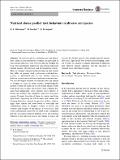Nutrient stores predict task behaviors in diverse ant species
Author(s)
Gordon, D.; Ingram, K. K.; Sigova, Alla A.
Download40_2016_Article_469.pdf (636.1Kb)
PUBLISHER_POLICY
Publisher Policy
Article is made available in accordance with the publisher's policy and may be subject to US copyright law. Please refer to the publisher's site for terms of use.
Terms of use
Metadata
Show full item recordAbstract
In eusocial species, including ants and honeybees, sterile or non-reproductive workers can specialize in task-specific behaviors, such as brood care and foraging for food. The mechanisms underlying task-specific behaviors include genetic, physiological and environmental factors. Here we compare corporeal nutrient storage in nine species that differ in primary food preferences (carbohydrate-, protein- or lipid-based diet) to test whether foraging behavior is associated with lower individual nutrient stores. We also investigate whether low nutrient stores are limited to foragers or occur in other external, morphologically distinct, worker sub-castes. In six out of eight species where both brood care workers and foragers were sampled, foragers had significantly lower nutrient stores relative to brood care workers; the exceptions were two Solenopsis species. Foragers from five of these six species had lower lipid levels, supporting the link between lipid content and foraging behaviors reported in previous studies. Interestingly, three species had lower levels of both lipid and carbohydrate stores in foragers relative to brood care workers, and foragers of one species, Formica fusca, had lower carbohydrate levels but not lipid levels, suggesting that the association between nutrient stores and foraging behavior is not universal across ant species or across all seasons. In all three species with morphologically distinct sub-castes, lipid levels were lowest in non-foraging, external workers, i.e., majors or soldiers, indicating an additional link between nutrient depletion and the allocation of external tasks other than foraging.
Date issued
2016-03Department
Massachusetts Institute of Technology. Department of BiologyJournal
Insectes Sociaux
Publisher
Springer International Publishing
Citation
Silberman, R. E., D. Gordon, and K. K. Ingram. “Nutrient Stores Predict Task Behaviors in Diverse Ant Species.” Insect. Soc. 63, no. 2 (March 4, 2016): 299–307.
Version: Author's final manuscript
ISSN
0020-1812
1420-9098